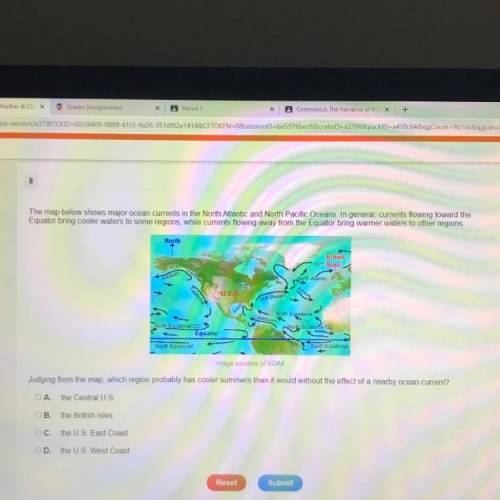
The map below shows major ocean currents in the North Atlantic and North Pacific Oceans. In general, currents flowing toward the
Equator bring cooler waters to some regions, while currents flowing away from the Equator bring warmer waters to other regions.
North
British
Isles
Askan
North Atlantic
Azor
U. S.A
California
Gulf Stream
Loop
n
Canbean
North Equatorial
North Equatorial CC
North Fuatorial
Equator
South Equatorial
Not
South Equatorial
Image courtesy of NOAA
Judging from the map, which region probably has cooler summers than it would without the effect of a nearby ocean current?
A the Central U. S.
B. the British Isles
C. the U. S. East Coast
D. the US West Coast


Answers: 3


Another question on Physics

Physics, 22.06.2019 16:30
The ph is the a.independent variable b.the dependent variable c.control group
Answers: 1

Physics, 22.06.2019 17:30
Does heating a metal wire increase or decrease its electrical resistance? why?
Answers: 1

Physics, 22.06.2019 20:00
Choose a realistic problem for which these are the correct freebody diagrams. be sure that the answer that the problem requests is consistent with the diagrams shown. choose a realistic problem for which these are the correct freebody diagrams. be sure that the answer that the problem requests is consistent with the diagrams shown. a 1.0 kg block is placed on top of a 2.0 kg block. a horizontal rope pulls the 2.0 kg block across a frictionless floor with a force of 21.0 n. the coefficient between the two blocks is 0.75. does the 1.0 kg block on top slide?
Answers: 3

Physics, 22.06.2019 23:00
Acommon technique in analysis of scientific data is normalization. the purpose of normalizing data is to eliminate irrelevant constants that can obscure the salient features of the data. the goal of this experiment is to test the hypothesis that the flux of light decreases as the square of the distance from the source. in this case, the absolute value of the voltage measured by the photometer is irrelevant; only the relative value conveys useful information. suppose that in part 2.2.2 of the experiment, students obtain a signal value of 162 mv at a distance of 4 cm and a value of 86 mv at a distance of 5.7 cm. normalize the students' data to the value obtained at 4 cm. (divide the signal value by 162.) then calculate the theoretically expected (normalized) value at 5.7 cm.
Answers: 2
You know the right answer?
The map below shows major ocean currents in the North Atlantic and North Pacific Oceans. In general,...
Questions

Mathematics, 24.10.2020 01:00

Chemistry, 24.10.2020 01:00

Mathematics, 24.10.2020 01:00


History, 24.10.2020 01:00


Mathematics, 24.10.2020 01:00

Advanced Placement (AP), 24.10.2020 01:00

English, 24.10.2020 01:00

Mathematics, 24.10.2020 01:00

History, 24.10.2020 01:00

Computers and Technology, 24.10.2020 01:00

Mathematics, 24.10.2020 01:00



Mathematics, 24.10.2020 01:00


Mathematics, 24.10.2020 01:00


Biology, 24.10.2020 01:00



